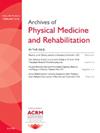Assessing Sensor-Derived Features From a Wrist-Worn Wearable Device as Indicators of Upper Extremity Function in Individuals With Cervical Spinal Cord Injury
IF 3.7
2区 医学
Q1 REHABILITATION
Archives of physical medicine and rehabilitation
Pub Date : 2025-09-01
DOI:10.1016/j.apmr.2025.03.003
引用次数: 0
Abstract
Objective
To assess the relationship between sensor-derived features and upper extremity function in individuals with acute and chronic cervical spinal cord injury (cSCI) and to assess the reproducibility of these features in chronic cSCI.
Design
Prospective, longitudinal study. Participants completed the Capabilities of Upper Extremity Test (CUE-T)—a measure of upper extremity function—at 2 time points, 4 weeks apart, while wearing a wrist-worn inertial measurement unit device on their most-used upper extremity. The device recorded 3-axis accelerometer and gyroscope data from which metrics (features) were derived. Distance correlations (dCorr) assessed associations between features and CUE-T hand and arm function scores. Intraclass correlation coefficients (ICCs) assessed the reproducibility of CUE-T scores and features in the chronic subgroup.
Setting
Inpatient rehabilitation facility (acute cSCI) and community (chronic cSCI).
Participants
Forty adults (N=40) with cSCI were enrolled, and 33 provided data.
Interventions
Not applicable.
Main Outcome Measures
Correlations between CUE-T scores and features; ICCs of CUE-T scores and features (chronic group).
Results
At Time 1, 2 features showed strong correlations with CUE-T hand score (dCorr, 0.53-0.58), while 9 showed strong correlations with CUE-T arm score (dCorr, 0.54-0.62). At Time 2, 3 features showed strong correlations with CUE-T hand score (dCorr, 0.53-0.57), while 29 showed strong correlations with CUE-T arm score (dCorr, 0.50-0.72). Types of features were distinct for hand and arm conditions. For the chronic subgroup, CUE-T scores showed excellent reproducibility (ICC, 0.94-0.99), and 16 features demonstrated moderate to good reproducibility (ICC, 0.50-0.77).
Conclusions
Sensor-derived features can indicate upper extremity function in cSCI, supporting their use for monitoring recovery and functional outcomes. Future research should focus on validating features of upper extremity function to support digital biomarker development and clinical adoption.
评估来自腕戴式可穿戴设备的传感器衍生特征作为颈脊髓损伤个体上肢功能的指标。
目的:评估急性和慢性颈脊髓损伤(cSCI)患者的传感器来源特征与上肢功能之间的关系,并评估这些特征在慢性cSCI中的可重复性。设计:前瞻性、纵向研究。参与者在两个时间点完成上肢能力测试(CUE-T)——上肢功能的测量——间隔四周,同时在他们最常用的上肢上佩戴腕式惯性测量单元(IMU)装置。IMU记录了3轴加速度计和陀螺仪的数据,由此得出了度量(特征)。距离相关性(dCorr)评估特征与CUE-T手和手臂功能评分之间的关联。类内相关系数(ICCs)评估慢性亚组CUE-T评分和特征的可重复性。环境:住院康复机构(急性cSCI)和社区(慢性cSCI)。参与者:40名成人cSCI患者入组,33名提供数据。干预:没有。主要结局指标:CUE-T评分与特征的相关性;慢性组的CUE-T评分及特征。结果:在时间1时,有2个特征与CUE-T手部评分有较强相关性(dCorr=0.53 ~ 0.58), 9个特征与CUE-T手臂评分有较强相关性(dCorr=0.54 ~ 0.62)。时间2时,有3个特征与CUE-T手部评分有较强相关性(dCorr=0.53 ~ 0.57), 29个特征与CUE-T手臂评分有较强相关性(dCorr=0.50 ~ 0.72)。手和手臂的特征类型是不同的。对于慢性亚组,CUE-T评分具有良好的可重复性(ICC=0.94-0.99), 16个特征具有中等至良好的可重复性(ICC=0.50-0.77)。结论:传感器衍生特征可以指示cSCI患者的上肢功能,支持其用于监测恢复和功能结局。未来的研究应侧重于验证上肢功能的特征,以支持数字生物标志物的开发和临床应用。
本文章由计算机程序翻译,如有差异,请以英文原文为准。
求助全文
约1分钟内获得全文
求助全文
来源期刊
CiteScore
6.20
自引率
4.70%
发文量
495
审稿时长
38 days
期刊介绍:
The Archives of Physical Medicine and Rehabilitation publishes original, peer-reviewed research and clinical reports on important trends and developments in physical medicine and rehabilitation and related fields. This international journal brings researchers and clinicians authoritative information on the therapeutic utilization of physical, behavioral and pharmaceutical agents in providing comprehensive care for individuals with chronic illness and disabilities.
Archives began publication in 1920, publishes monthly, and is the official journal of the American Congress of Rehabilitation Medicine. Its papers are cited more often than any other rehabilitation journal.

 求助内容:
求助内容: 应助结果提醒方式:
应助结果提醒方式:


